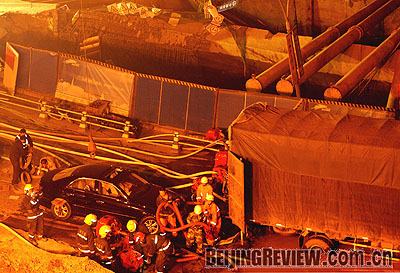|

SIGNS OF LIFE: Rescue workers search for survivors at the collapsed subway tunnel construction site in Hangzhou, capital of east China's Zhejiang Province, on November 15
"Some colleagues who moved slowly were buried," murmured Zhu Juzhong, a 56-year-old worker who was still in horror after surviving a subway tunnel collapse in the east Chinese city of Hangzhou on November 15.
The incident happened at 3:20 p.m. that day when a 75-meter-long, 50-meter-wide and 15-meter-deep section of road collapsed into the tunnel in the capital of Zhejiang Province, trapping about 50 workers and 11 vehicles.
"There is some distance between where I was working and the cave-in site. Lots of workers rushed to the hoist to be lifted above ground. The height is about 10 meters," said Zhu, a construction worker from Sichuan Province in the southwest. He suffered slight injuries.
About 30 workers managed to escape on the hoist. Three fell from it during the scramble to escape, he added.
The injured workers were hospitalized and all the people in trapped vehicles survived. At last count on November 21, the death toll was nine and rescuers continued to search for 12 missing workers.
More than 1,000 policemen and firefighters are participating in the rescue work. The construction operator, China Railway Construction Group Co. Ltd., has halted all subway construction works in the city for safety checks, said the group's vice president Bai Zhongren.
The province has set up an investigation group to find out the cause of the accident, and a panel of experts from Beijing Jiaotong University, Beijing Urban Engineering Design and Research Institute Co. Ltd. and Zhejiang University is working on the rescue operation.
Local authorities have evacuated three households near the cave-in site on the advice of the panel. The houses will be demolished to make way for mechanical equipment needed in the search and rescue operation, Bai said.
Hangzhou has launched a citywide check of all its 35 subway construction sites, which have been ordered to shut down temporarily.
The cause of the disaster is still under investigation. According to Yang Guoxiang, chief engineer of tunnel design, the cause may involve three key factors: the condition of the earth around the site, the foundation pit design and the construction operation.
Yang noted that Hangzhou is located on the alluvial plain, which mostly consists of soft soil, leading to a high risk of construction site cave-ins.
Zhao Tiechui, Vice Minister of the State Administration of Work Safety, inspected the cave-in site. He said the cause should be investigated thoroughly and the findings made public.
According to China Central Television, 30 of the country's largest cities with millions living in each of them are building or planning to build subways.
In recent years there have been a number of accidents involving subway-construction sites across the country. On March 28 last year, a section of Beijing No.10 subway line collapsed, killing six construction workers. On April 1, 2008, a subway construction accident in Shenzhen killed three and injured two.
Experts said the Hangzhou tunnel collapse should serve as a warning to officials engaged in metro expansion projects across the country.
China's major cities, including Beijing and Guangzhou, have strengthened safety measures following the subway tunnel collapse in Hangzhou.
Authorities in Beijing, where seven urban railway lines are being built, have vowed to intensify checks on all construction sites. They promised to install closed-circuit TV cameras to monitor sites around the clock, Beijing Youth Daily reported.
Wu Hongjian, General Manager of Beijing Railway Construction and Management Co, said cameras would be installed at all seven lines under construction.
According to Nanfang Daily, in Guangzhou, where seven subway projects are under construction, a team of 120 officials has begun daily patrols of more than 200 sites. Each subway project has a six-person team to monitor the sites deemed most risky.
A recent report by the Development Research Center of the State Council showed that proper safety measures have long been lacking in China's large-scale subway projects.
"The accident in Hangzhou is unlikely to make cities with subway plans slow their pace, but it should make them realize that safety has to be the top concern," said Miao Yanying of the Subway and Metro Railway Research Center under the Ministry of Housing and Urban-Rural Development.
| 